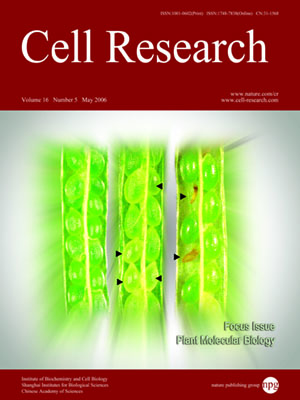
Volume 16, No 5, May 2006
ISSN: 1001-0602
EISSN: 1748-7838 2018
impact factor 17.848*
(Clarivate Analytics, 2019)
Volume 16 Issue 5, May 2006: 489-498
ORIGINAL ARTICLES
Proteomic identification of potential target proteins regulated by an ASK1-mediated proteolysis pathway
Xiaofeng Wang, Weimin Ni, Xiaochun Ge, Jiejin Zhang, Hong Ma, Kaiming Cao
1State Key Laboratory of Genetic Engineering, Department of Biochemistry and Molecular Biology, School of Life Sciences, Fudan University, Shanghai, 200433, China; 2Department of Biology and the Huck Institutes of the Life Sciences, the Pennsylvania State University, University Park, Pennsylvania 16802, USA
Correspondence: Xiaochun Ge, Hong Ma(xcge@fudan.edu.cn hxm16@psu.edu)
The ASK1 (ARABIDOPSIS SKP1-LIKE) protein is a critical component of the SCF (Skp1-Cullin-F box protein) ubiquitin ligase complexes that recruit target proteins for degradation by the 26S proteosome. To investigate proteins that are affected by the ASK1-mediated proteolysis pathway in Arabidopsis flowers, we compared the proteomes of the Arabidopsis wild type and ask1 mutant flower buds using two-dimensional electrophoresis (2-DE). Ten protein spots with higher or lower abundance in the ask1 mutant flowers compared to wild type flowers were excised and subjected to further mass spectrometry (MS) analysis. The results showed that they were proteins involved in photomorphogenesis, circadian oscillation, post-translation process, stress-responses and cell expansion or elongation, suggesting that those processes were affected in the ask1 mutant. The transcript levels of these genes were also compared based on the Affymetrix gene chip microarray data. No significant difference was observed for most of the genes, suggesting that the proteins with elevated levels of accumulation in the ask1 mutant could be candidate targets regulated by an ASK1-mediated proteolysis pathway. These results help to elucidate the pleiotropic functions of ASK1 in Arabidopsis developmental processes and also demonstrate the importance and necessity of studying protein levels with respect to gene functions.
Cell Research (2006) 16:489-498. doi:10.1038/sj.cr.7310060; published online 15 May 2006
FULL TEXT | PDF
Browse 1952


